Important Message
This Website Terms and Condition of Use Agreement
also known as a 'terms of service agreement'
Will be at the bottom of most web pages!
Please read it before using this website.
Thank You
|
| Khe Sanh Historic Road Marker |
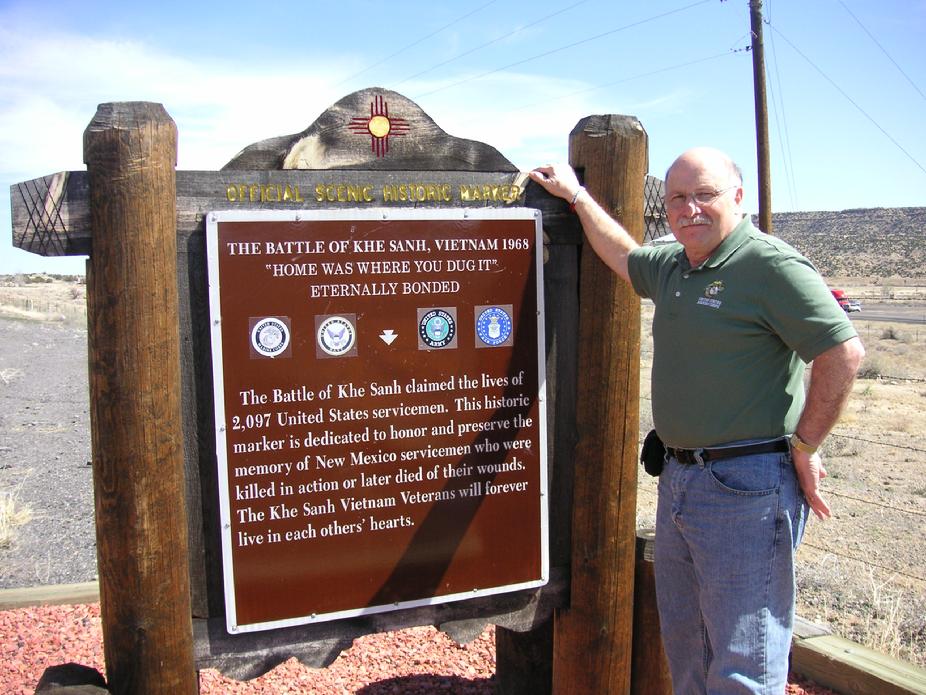 |
| March 2015 |
|
|
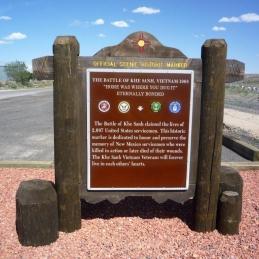 |
| On the south side of NM-124 (old US-66) just east of I-40 exit 104. |
|
|
|
35 03 05.4N 107 30 49.9W
| Khe Sanh Bridge
Bridge dedicated in April 2010 to the 10 New Mexico servicemen who sacrificed their lives in the battle of Khe Sanh Vietnam in 1968
|
A Place That Always Was
By Craig W. Tourte
H.Q. 1/13 Khe Sanh 67-68
On Tuesday, November 10, 2009, the state of New Mexico dedicated and unveiled an Official Scenic Historic Road Marker honoring those who died at “The Battle of Khe Sanh, Vietnam 1968.” The beautiful wooden marker is inscribe: “The Battle of Khe Sanh claimed the lives of 2,097 United States servicemen. This historic marker is dedicated to honor and preserve the memory of New Mexico servicemen who were killed in action or later died of their wounds. The Khe Sanh Vietnam veterans will forever live in each others’ hearts.” In addition, the marker is inscribed with the names of nine of those who were killed from the State of New Mexico. I am sure more names will eventually be included, as that information becomes available.
“The location of the “Official Scenic Historic Marker” is identified as being at New Mexico 124, Mile Marker 16.5. In actuality, it sits along the old Historic Route 66 Highway, North of Interstate 40 at the 104 Exit in an area identified as Acoma, New Mexico. It was an approximate 50 mile drive along Interstate 40 from the City of Albuquerque to reach an area known as “The Sky City.” The Sky City is actually an area where the Acoma people lived centuries ago atop a mesa to protect themselves from enemy attacks by neighboring bands. The Native American’s who live in the area are identified as the “Acoma” which means “Place of readiness.” According to a little research, “Native American legend” describes Acoma as a “place that always was.” Native history says “…it was first inhabited about 700 A.D.” “Archaeologists agree that it has been continuously occupied from at least 1150 A.D. to the present.” Acoma, New Mexico is generally considered “America’s oldest continually inhabited city.”
The drive from Albuquerque to “The Sky City” where the Historic Marker is located is not unlike any other drive I have taken along a desolated high desert highway. Long, straight and lonely for the bored and weary traveler who too often focuses attention on what’s over the next rise. One could pass Acoma in the blink of an eye and never know anything was there except sand, sagebrush and red dirt. I wondered why a monument honoring these heroes would be erected in such a desolate location and not in a more densely populated area.
It was early evening when I drove out to the site of the Historic Road Marker where I met Harold E. Lockwood (HMH-CH-53 Sea Stallions) for the first time. Harold is a tall, proud Native American, former Marine and Vietnam Veteran who is the Sergeant at Arms of the National American Indian Veterans. We stood together as darkness approached, surrounded by red sky with a few wispy clouds off in the distance and tall red table top mountains rising up from the desert floor. Harold identified his house a quarter mile or so away from where we were standing. With the swing of his arm in a wide arc he told me about his cousins, friends, other relatives and Native Americans who lived nearby and identified those who had served and those who had made the ultimate sacrifice, all from the Reservations. We talked about the arrival of the early Missionaries, the Native American children who had been taken from their parents and even to this day, the hardships his people face.
We spent a few minutes talking about his service in the United States Marine Corps and the three years he served in Vietnam. The tragically brutal injuries and death he had observed as a helicopter machine gunner, too often recovering the dead and wounded. The missions off of ships made by young boys who eagerly entered combat for the first time, all dressed in new green uniforms and combat gear and his painful recovery of their remains after the battles. Harold remembered all of these events clearly and with great sadness as he looked up into that red evening sky, silently remembering the pain that is often overwhelming, as he searched for the words that would somehow explain to the outsider, the horrors he had witnessed. Remembrances I knew were still prevalent.
The following day during the dedication ceremony there were a group of young children from one of the local Native American schools who preformed a dance. Adorned in Native American costume, I observed they all had very intense looks on their faces. I realized that the dance these children performed was a serious cultural interpretation of events and beliefs that had been handed down from one generation to the next. The dance was significant to the Native People and fitting in that it was performed in memory of those who had sacrificed for their people and our country.
As I stood alone looking out across the Acoma, viewing the red earth color of the valley and hills, not so dissimilar in color to the red clay of Khe Sanh, I glanced up into the very wide open sky and understood why fate had brought “The Battle of Khe Sanh” marker here. Somehow fate had brought this remembrance marker to this spot, because this place is a “Place That Always Was,” A “Place of Readiness” and in a way, a place of safety for those who we will never forget.
Craig W. Tourte
|
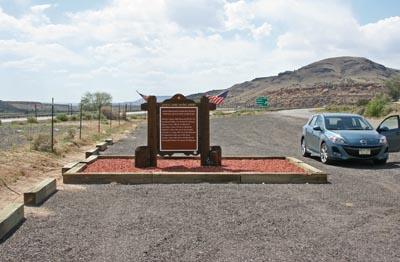 |
| New Mexico – near Paraje – Honors the 2,097 United States servicemen who died in the battle of Khe Sanh, Vietnam, and specifically those from New Mexico. The I-40 overpass at exit 104 is marked as the “Khe Sanh Bridge”. |
|
|
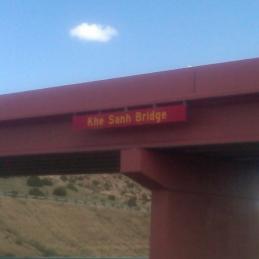 |
| This bridge is over Interstate 40, about 50 miles west of Albuquerque. |
|
|
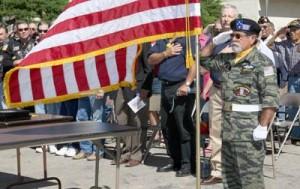 |
| Vietnam veteran Juan Apodaca salutes the American flag as it waves during the opening cermonies of the Khe Sanh bridge dedication. |
|
|
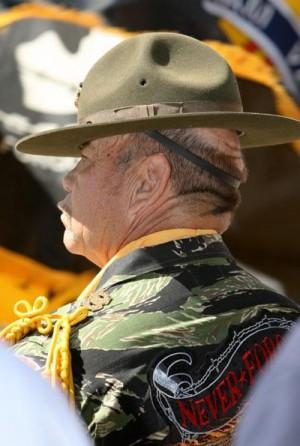 |
| A veteran respectfully listens as Retired Colonel Allen Weh speaks at the Khe Sanh Bridge dedication. |
|
|
CIBOLA COUNTY - On May 26, transportation officials were joined by members of Khe Sanh Veterans, Inc., New Mexico Department of Veterans Services, Vietnam Veterans of America and local officials to pay tribute to veterans at a dedication ceremony for the new Khe Sanh Bridge.
The bridge was dedicated to honor and preserve the memory of those servicemen who were killed in action or later died of their wounds while fighting at the Battle of Khe Sanh, Vietnam. The Battle of Khe Sanh claimed the lives of 2,097 U.S. servicemen.
In November 2009, an official scenic historic marker was erected alongside Highway 124 (the historic Route 66) about one mile east of the Khe Sanh Bridge. The historic marker was dedicated to the ten New Mexico servicemen who lost their lives at the Battle of Khe Sanh. In April 2010, the State Transportation Commission approved naming the structure to the Khe Sanh Bridge. The structure will symbolize bridging the gap that bonds all veterans and their families together and will forever keep them in each other's hearts.
Transportation officials and dignitaries such as Representative Ken Martinez, Allen Weh, a veteran of the battle and a Republican governor candidate and Cibola County Commission Chairman Eddie Michael were among the speakers at the event that drew a crowed of more than 100 people. Weh is a retired colonel who spoke at the event of his first assignment experience at Khe Sanh.
“Many veterans from all over the country fought and lost their lives at this battle,” said Transportation Commission Chairman Johnny Cope. “The Khe Sanh Bridge is dedicated to their courage and sacrifice.”
“I am deeply honored to dedicate this bridge to those who served at Khe Sanh and gave the ultimate sacrifice,” said District Six Transportation Commissioner Jackson Gibson. “As a Vietnam veteran, I am also proud that the traveling public will be reminded of our freedom and the price that comes with that freedom, every time they drive along the Khe Sanh Bridge.”
“Our veterans are heroes and the Khe Sanh Bridge stands as a symbol of their battle for freedom,” said Transportation Secretary Gary L.J. Girón. “Their sacrifice and service will never be forgotten.”
The Khe Sanh Bridge, located along I-40 at Exit 104, was reconstructed in 2008.
|
This website contains, in various sections, portions of copyrighted material not specifically authorized by the copyright owner. This material is used for educational purposes only and presented to provide understanding or give information for issues concerning the public as a whole. In accordance with U.S. Copyright Law Title 17 U.S.C. Section 107, the material on this site is distributed without profit. More Information
Information presented based on medical, news, government, and/or other web based articles or documents does not represent any medical recommendation or legal advice from myself or West Saint Paul Antiques. For specific information and advice on any condition or issue, you must consult a professional health care provider or legal advisor for direction.
I and West Saint Paul Antiques can not be responsible for information others may post on an external website linked here ~ or for websites which link to West Saint Paul Antiques. I would ask, however, that should you see something which you question or which seems incorrect or inappropriate, that you notify me immediately at floyd@weststpaulantiques.com Also, I would very much appreciate being notified if you find links which do not work or other problems with the website itself. Thank You!
Please know that there is no copyright infringement intended with any part of this website ~ should you find something that belongs to you and proper credit has not been given (or if you simply wish for me to remove it),
just let me know and I will do so right away.
|
Website Terms and Condition of Use Agreement
also known as a 'terms of service agreement'
By using this website, West Saint Paul Antiques . Com, you are agreeing to use the site according to and in agreement with the above and following terms of use without limitation or qualification. If you do not agree, then you must refain from using the site.
The 'Terms of Use' govern your access to and use of this website and facebook pages associated with it. If you do not agree to all of the Terms of Use, do not access or use the website, or the facebook sites. By accessing or using any of them, you and any entity you are authorized to represent signify your agreement to be bound by the Terms of Use.
Said Terms of Use may be revised and/or updated at any time by posting of the changes on this page of the website. Your continued usage of the website, or the facebook site(s) after any changes to the Terms of Use will mean that you have accepted the changes. Also, any these sites themselves may be changed, supplemented, deleted, and/or updated at my sole discretion without notice; this establishes intellectual property rights by owner (myself).
It saddens me to include a Terms of Use for West Saint Paul Antiques . Com, but we all realize it is something that is necessary and must be done these days. By using the website, or facebook for West Saint Paul Antiques, you represent that you are of legal age and that you agree to be bound by the Terms of Use and any subsequent modifications. Your use of the West Saint Paul Antiques sites signify your electronic acceptance of the Terms of Use and constitute your signature to same as if you had actually signed an agreement embodying the terms.
|
|